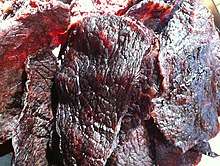Yukpo
Yukpo (Korean: 육포) is a type of po or dried meat, made from beef.[1] It is a traditional Korean food, commonly eaten as snack food, banchan (food accompanying bap) or anju (food accompanying sul).[1][2][3] It is also one of the foods prepared for traditional occasions such as pyebaek (formal greetings from the newlyweds after the wedding ceremony) and jesa (ancestral rite).[4][5]
 Hanu-yukpo (dried Korean beef) | |
| Type | |
|---|---|
| Place of origin | Korea |
| Associated national cuisine | Korean cuisine |
| Main ingredients | Beef |
| Similar dishes | Beef jerky |
| Korean name | |
| Hangul | 육포 |
|---|---|
| Hanja | 肉脯 |
| Revised Romanization | yukpo |
| McCune–Reischauer | yukp'o |
| IPA | [juk̚.pʰo] |
Name
The Sino-Korean word yukpo (육포, 肉脯) is a compound of yuk (육, 肉), meaning "meat", and po (포, 脯), meaning "dried meat or fish". Because beef is the default meat in Korean cuisine, many beef dishes such as yukpo and bulgogi are referred using the words gogi (고기) or yuk (육, 肉), meaning "meat", rather than soegogi (쇠고기) or uyuk (우육, 牛肉), meaning "cow meat".
History
Varieties
Dried thinly sliced beef is usually called geonpo (건포, 乾脯), while when the meat is pounded flat and dried it is called pyeonpo (편포, 片脯). When the beef is seasoned with salt and pepper, it is called yeompo (염포, 鹽脯), while the dried beef seasoned or marinated with soy sauce-based seasonings are called jangpo (장포, 醬脯), pyeonpo (편포, 片脯), sanpo (산포, 散脯), or yakpo (약포, 藥脯), according to the methods.[6]
- Baepo (배포, 焙脯) – thinly sliced beef or pork, seasoned and dried on baerong (배롱, 焙籠) on fire[7]
- Jangpo (장포, 醬脯) – thick slices of lean meat is repeatedly grilled to sear skin, beaten with bats, and seasoned with aged soy sauce, until thoroughly cooked[8]
- Jeotguk-po (젓국포) – thinly sliced beef, parboiled in water and jeotguk (liquid from salted seafood) and dried[9]
- Possam (포쌈) – thinly sliced beef, seasoned, beaten, cut into circles, stuffed with a few pine nuts and sealed into half-moon shape, dried and grilled[10]
- Pyeonpo (편포, 片脯) – beef is pounded flat with knife, and dried[11]
- Sanpo (산포, 散脯) – sliced pieces of beef is massaged with salt and sun-dried[15]
- Yakpo (약포, 藥脯) – meat is thinly sliced, seasoned with soy sauce, oil, sugar, and pepper, massaged, and dried on sokuri[16]
Use
Yukpo is eaten as snack food, banchan (food accompanying bap) or anju (food accompanying sul).[1][3] Salted and dried yukpo is eaten as po-jaban (포자반), a salty banchan.[17] Yukpo is also one of the foods prepared for traditional occasions such as pyebaek (formal greetings from the newlyweds after the wedding ceremony) and jesa (ancestral rite).[4][5]
See also
- Beef jerky
- Dried meat
- List of beef dishes
References
- Korean Food Guide 800. Seoul: The Korea Foundation. 2014. ISBN 978-89-89782-10-0. Retrieved 28 September 2018.
- Park, Si-soo (28 March 2014). "'Yukpo' ㅡ delicacy made by toil, patience". The Korea Times. Retrieved 28 September 2018.
- Pettid, Michael J. (2008). Korean Cuisine: An Illustrated History. London: Reaktion Books. p. 61. ISBN 978-1-86189-348-2. Retrieved 28 September 2018.
- Park, Ji-Hyoung; Lee, Kyung-Hee (2005). "Quality Characteristics of Beef Jerky made with Beef meat of various Places of Origin". Korean Journal of Food and Cookery Science. 21 (4): 528–535. Retrieved 28 September 2018.
- Lee, Chang Hyeon; Kim, Young (2018). "Jongka, the traditional Korean family: Exploring jongka food in the context of Korean food categories". Journal of Ethnic Foods. 5 (1): 40–53. doi:10.1016/j.jef.2018.02.006.
- "특별음식". 조선의 오늘 (in Korean). 평양모란봉편집사. 2 December 2014. Retrieved 28 September 2018.
- "Baepo" 배포. Standard Korean Language Dictionary (in Korean). National Institute of Korean Language. Retrieved 28 September 2018.
- "Jangpo" 장포. Standard Korean Language Dictionary (in Korean). National Institute of Korean Language. Retrieved 28 September 2018.
- "Jeotguk-po" 젓국포. Standard Korean Language Dictionary (in Korean). National Institute of Korean Language. Retrieved 28 September 2018.
- "Possam" 포쌈. Standard Korean Language Dictionary (in Korean). National Institute of Korean Language. Retrieved 28 September 2018.
- "Pyeonpo" 편포. Standard Korean Language Dictionary (in Korean). National Institute of Korean Language. Retrieved 28 September 2018.
- "Daechu-pyeonpo" 대추편포. Standard Korean Language Dictionary (in Korean). National Institute of Korean Language. Retrieved 28 September 2018.
- "Jang-pyeonpo" 장편포. Standard Korean Language Dictionary (in Korean). National Institute of Korean Language. Retrieved 28 September 2018.
- "Jin-pyeonpo" 진편포. Standard Korean Language Dictionary (in Korean). National Institute of Korean Language. Retrieved 28 September 2018.
- "Sanpo" 산포. Standard Korean Language Dictionary (in Korean). National Institute of Korean Language. Retrieved 28 September 2018.
- "Yakpo" 약포. Standard Korean Language Dictionary (in Korean). National Institute of Korean Language. Retrieved 28 September 2018.
- "Po-jaban" 포자반. Standard Korean Language Dictionary (in Korean). National Institute of Korean Language. Retrieved 28 September 2018.
External links
